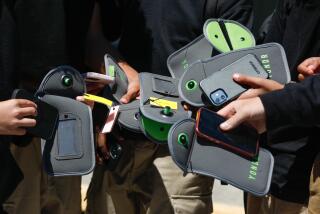Rebooting L.A. Unified’s iPad plan
- Share via
John Deasy, the superintendent of the Los Angeles Unified School District, can be impatient and stubborn, qualities we often admire in him. It takes a sense of urgency to get things moving in L.A.’s schools, as well as a willingness to stand against the forces that resist change.
But it is important for the superintendent to pick his battles wisely, and he fell short on that score when he forged ahead on a $1-billion project to equip every student in L.A. Unified with an iPad. He expressed great confidence that the district had the answers to a number of important and easily foreseeable problems when, in fact, it didn’t. The resulting embarrassments — students easily breaching the tablets’ security firewall, confusion about who is responsible for lost or broken devices, missing iPads from the pilot program — have incited a public backlash and prompted new questions on the part of the school board, which is convening a special meeting Oct. 29 to discuss the matter.
Deasy wisely called last week for slowing down the planned iPad rollout. His is a difficult task, finding the balance that will allow him to get all the problems worked out while ensuring that all students have equal access to the latest equipment. For all the complaints about the hundreds of millions of dollars to be spent on this project, few would deny that the future of education, jobs and daily life is being transformed by technology. Some taxpayers may believe that the district cannot afford pricey digital equipment. In reality, what the district cannot afford is to leave its students out of the computer era.
Any project so massive and entirely new is certain to involve some mistakes and, yes, even some waste. That said, it is more important for L.A. Unified to move carefully than to move quickly.
Here are some of the possibilities that Deasy and the school board should consider:
• Get rid of the timeline altogether and replace it with a performance-based rollout. Deasy’s revised schedule delays the complete purchase by only a matter of months. That might not be enough. Or it might be more than the district needs. The important thing to do is to move very slowly at first, examining and appraising every aspect of the project early on, and remaining flexible. Maybe loss, damage or theft will be bigger issues than expected, or maybe they will barely register. Where the district has erred so far is by assuming that it can predict outcomes, rather than observing outcomes and adjusting accordingly.
Deasy has pushed for a quick rollout on the argument that the new Common Core curriculum tests, which will officially replace the old state standardized tests in 2014, are designed to be taken on computers. That’s true, but the state will provide pencil versions until at least 2017. And even then, schools aren’t expected to need a computer or similar device for every student; the new testing system will allow schools to test in shifts so that equipment can be shared.
• Worry less about restricting students’ access to the Internet. It’s hardly a surprise that students quickly found their way to supposedly off-limits sites; since then, the district has been examining new security measures to ensure that students don’t have access to online games or, worse, places where they might encounter serious bullying or even child predators. But perhaps this is a battle that’s not worth fighting. Children and teenagers around the world have broad access to the Internet, which is increasingly essential to every student’s education. Does it really matter if L.A. Unified students also use their iPads for play or social media in addition to homework?
A better approach might be to hold meetings to make sure that parents understand the potential dangers of the Internet and what to watch for. Concerns about legal liability might be overcome by having parents sign releases accepting responsibility for their children’s actions.
• Consider purchasing a mix of equipment. Loss, theft or damage might turn out to be problems for which, despite the best planning efforts, there is no good solution. If that proves true during the first year or so of the rollout, district leaders should be flexible enough to consider including less expensive equipment, rather than providing every student with a $700 iPad. For example, the youngest students might be better off without the Internet access required for older students, and therefore able to work on a less expensive device.
• Assess the results, early and regularly. The district is planning to invest $1 billion in this project, half for the tablets, the rest for upgrading campuses with Wi-Fi, training staff and so forth. It also should invest in regular, outside assessment of its equipment and software. Some teachers appear to like the educational software being purchased from Pearson Education, which was pre-loaded onto the iPads. But there have been numerous complaints about it as well. The decision to buy this particular software also has come under criticism because the deputy superintendent who was in charge of the iPad project had previously worked for a subsidiary of Pearson.
The purpose of this very expensive project is to provide a better education for students: more engaging lessons, more sophisticated technology skills and higher achievement. We believe, along with Deasy, that tablets can deliver all three. But the district should take the time during the early phases of the project, before it commits to buying all 650,000 iPads, to have objective, expert eyes determine that the project is achieving its aims.
More to Read
A cure for the common opinion
Get thought-provoking perspectives with our weekly newsletter.
You may occasionally receive promotional content from the Los Angeles Times.










